| |||||||
| Search Forums |
| Advanced Search |
| Go to Page... |
 |
| Search this Thread |  22,934 views |
| | #1 |
| Newbie Join Date: Nov 2018 Location: Bengaluru
Posts: 21
Thanked: 175 Times
| Hampi,Badami and more: A journey back in time! After reading so much about Hampi, it was just a matter of time before we visited this ancient empire. The plan to visit Hampi finally materialised during the Christmas break when we finally got the chance to visit this historical place. This is my first travelogue on Team-BHP. Kindly excuse me for any shortcomings. Besides Hampi we visited Badami, Aihole, Pattadakal and Chitradurga. Initially the plan was to stay at Hospet for 2 nights and then head to Badami and stay there for another night before returning to Bangalore. So, we went ahead and booked a room for 2 nights at Royal Orchid Kireeti in Hospet (22-24 December). The journey from Badami to Bangalore is 450 odd kilometres and we wanted to visit the Chitradurga fort enroute. This way we wouldn’t be able to spend enough time at Chitradurga so we changed our plan and decided to go to Badami and return back the same day and stay at Hospet itself. Went ahead and booked a room for another night (24-25 December) at KSTDC Mayura Bhuvaneshwari in Kamalapur as Royal Orchid was completely booked by then. Route Plan: After going through the route queries here on Team-BHP decided to take the Bangalore-Chitradurga-Mustur-Kudligi-Hospet route. We stuck to NH50 from Chitradurga to Hospet and did not take a diversion at Mustur as indicated by google maps. Our Drive: The Hyundai Creta Petrol Last edited by Futurestan : 5th January 2019 at 13:50. |
| |  (8)
Thanks (8)
Thanks
|
| The following 8 BHPians Thank Futurestan for this useful post: | GTO, InControl, jayantvs, mpksuhas, Rajeevraj, rj22, Samba, Voodooblaster |
| |
| | #2 |
| Newbie Join Date: Nov 2018 Location: Bengaluru
Posts: 21
Thanked: 175 Times
| Re: Hampi,Badami and more: A journey back in time! Day1-Saturday,22nd December Bangalore-Hospet-Anegundi-Hospet We started from home at about 5:45 am. There was a slightly long line at the first toll on Tumkur road but thereafter after crossing Tumkur the traffic became slightly lesser. Some parts of the highway was covered in fog and visibility was reduced to about 300 metres but was not a problem at all. It was smooth sailing till Chitradurga. Some pictures taken on NH48  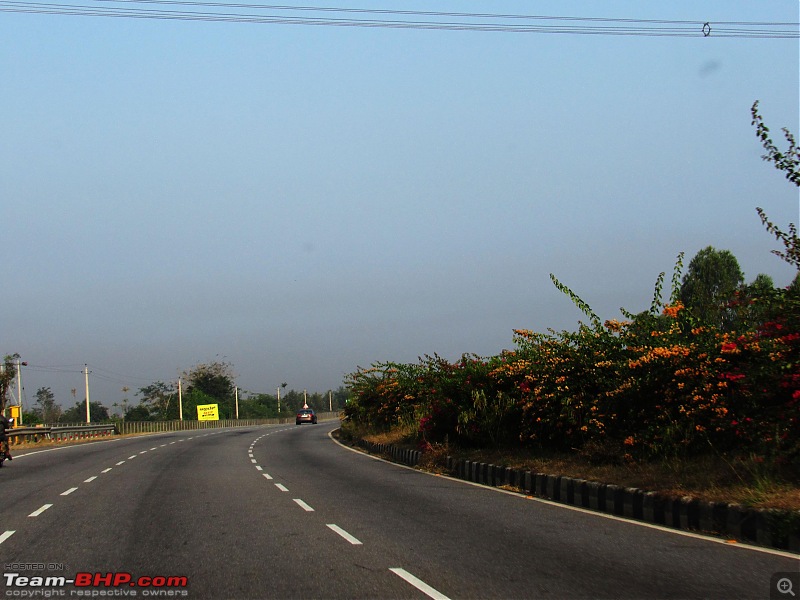  After crossing Chitradurga we got onto NH50. The NH50 is still not fully completed and there are n number of diversions. The road conditions were partly bad but the only boon was that the traffic was less. It was 70% of truck and bus traffic. The truck traffic was disciplined and hence it was not much of a problem along the entire route.There are hardly any family restaurants after crossing Chitradurga. Most of them are shut due to the road work that is going on. Some pictures taken on NH50 The bad sections  The almost finished sections that rarely come by  A tunnel just before entering Hospet  We reached Hospet by 12:40 pm and check into our hotel. After a little rest and freshening up we went to have lunch at a nearby restaurant and were done with our lunch by around 3:30 pm. From there we went onto Anegundi. Anegundi Anegundi is the part of Hampi that situated on the northern bank of River Tungabhadra. Anegundi is believed to be the monkey kingdom of Kishkindha in the epic of Ramayana. Anegundi is about 27 kms from Hospet. First we visited the 64 pillar mantapa which on google maps is named as Sri Krishnadevaraya Tomb which I am not sure whether true or not.  The next stop was Anjanadri Hill which is believed to be the birthplace of god Hanuman. One needs to climb 550 odd steps to get to the top of Anjanadri Hill. There is a temple atop the hill. Anjanadri Hill is considered as one of the best locations in Hampi to witness the sunset from. You get to admire the vast expanse of boulders around you with the Tungabhadra River flowing along. One can also see the Vijaya Vithala Temple from atop the hill. Covered with boulders as far as the eye can see  The Vijaya Vithala Temple  You can also spot the famous stone chariot in the above image. The Creta shot from atop the hill  A beautiful tree  Few shots of the mesmerizing sunset     Try and take time to visit Anjandri hill as the view of the surrounding areas and the sunset is truly worth it. After witnessing the sunset we had dinner at Hospet and returned to our room. Last edited by Futurestan : 5th January 2019 at 14:13. |
| |  (20)
Thanks (20)
Thanks
|
| The following 20 BHPians Thank Futurestan for this useful post: | ampere, dailydriver, darklord, ganeshb, GTO, hemanth.anand, Insearch, jailbird_fynix, mpksuhas, paragsachania, procrj, R-Six, Rajeevraj, Samba, SDP, SmartCat, SNayak, sukiwa, Thermodynamics, Voodooblaster |
| | #3 |
| Newbie Join Date: Nov 2018 Location: Bengaluru
Posts: 21
Thanked: 175 Times
| Re: Hampi,Badami and more: A journey back in time! Day2-Sunday,23rd December Hospet-Aihole-Pattadakal-Badami-Hospet We had breakfast and left from Hospet by 7:45 am. We did not take our Creta but rented an Etios for the day’s journey. Aihole is about 130 kms from Hospet. Reached Aihole by around 10:00 am. Aihole Aihole was an early medieval era meeting place and a cradle for experimentation of Hindu arts, particularly temple architecture by the Chalukya Dynasty. Inscriptions dating back to the 6th Century have been found. During the course of perfecting their art of building temples, many temples were built at Aihole by the Chalukya Dynasty. So Aihole represents the early phases of the Chalukyan architecture before they eventually moved onto Pattadakal in the 8th century, which represents the mature phase of Chalukyan architecture. After the Chalukyas, the region became a part of the Rashtrakuta Kingdom who ruled in the 9th and 10th century. In the 11th and 12th century, the Late Chalukyas ruled over this region. In the 13th century and thereafter, the Malprabha valley along with much of Deccan became a target of raids and plunder by the Delhi Sultanate armies devastating the region. From the ruins emerged the Vijayanagara Empire which built forts and protected the monuments, as evidenced by inscriptions in the fort at Badami. [source-wikipedia] Durga Temple Complex It has a misleading name, because the temple is not named after goddess Durga.   A few of the many carvings that are present outside the Durga Temple   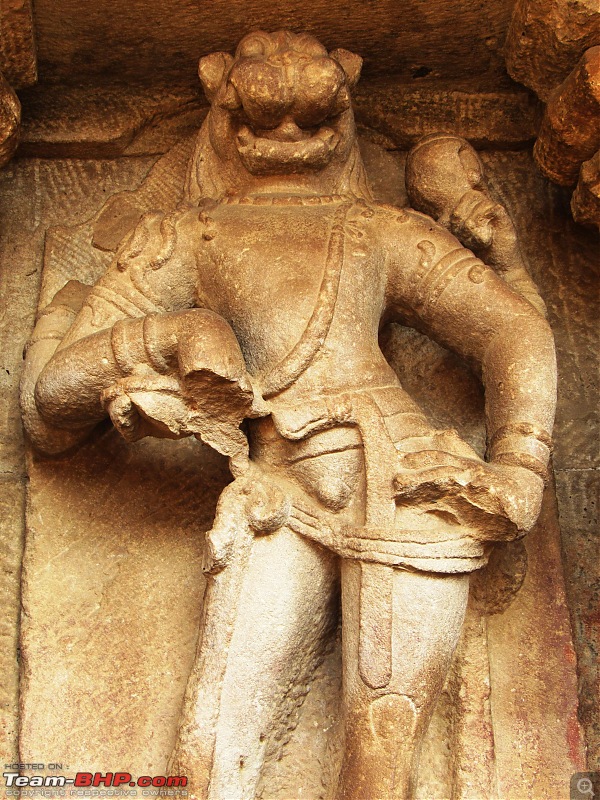 Few other temples near the Durga Temple 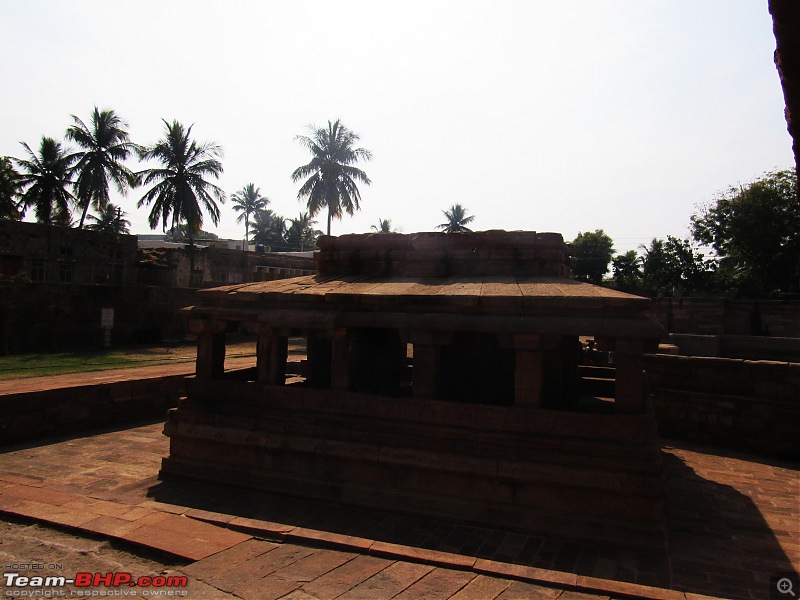  A stepped well near the Durga Temple 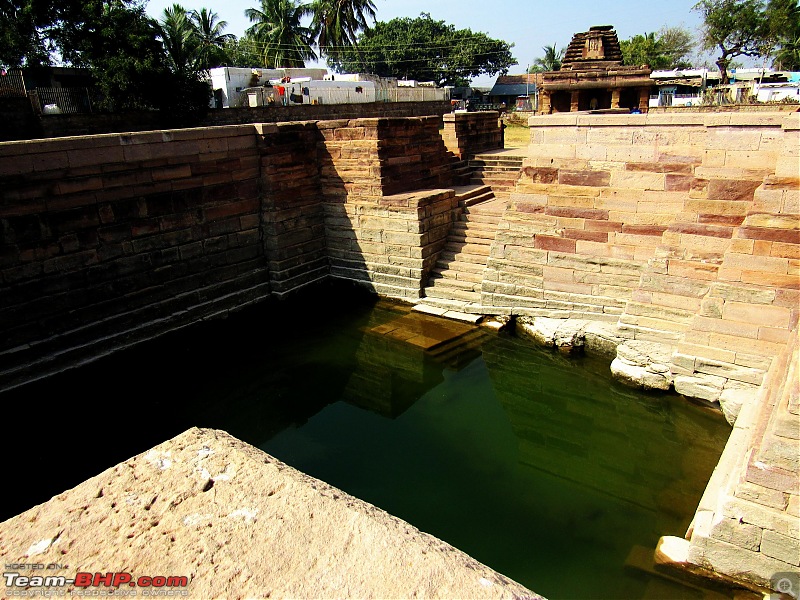 A museum is present within the complex 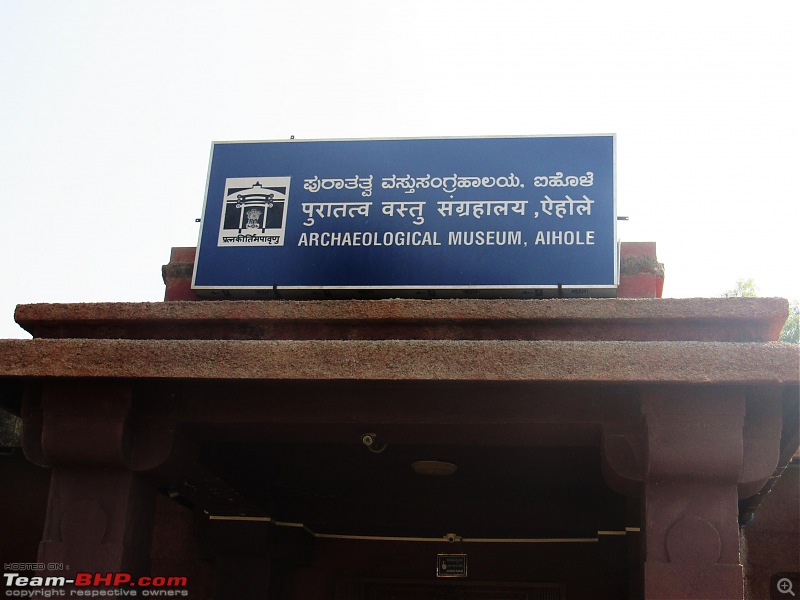 From Aihole we went to Pattadakal. The distance between Aihole and Pattadakal is about 13 kms. Pattadakal Pattadakal is situated on the west bank of the Malaprabha River. Pattadakal got its name because it was a place of coronation of the kings. It is considered as a holy place because the Malaprabha River in this region flows from south to north. Pattadakal has also been recognised as a UNESCO world heritage site. The temples here are a blend of northern and southern architecture. There is a mix of both Aryan and Dravidian architecture. Hence Pattadakal represents the mature phase of Chalukyan architecture. 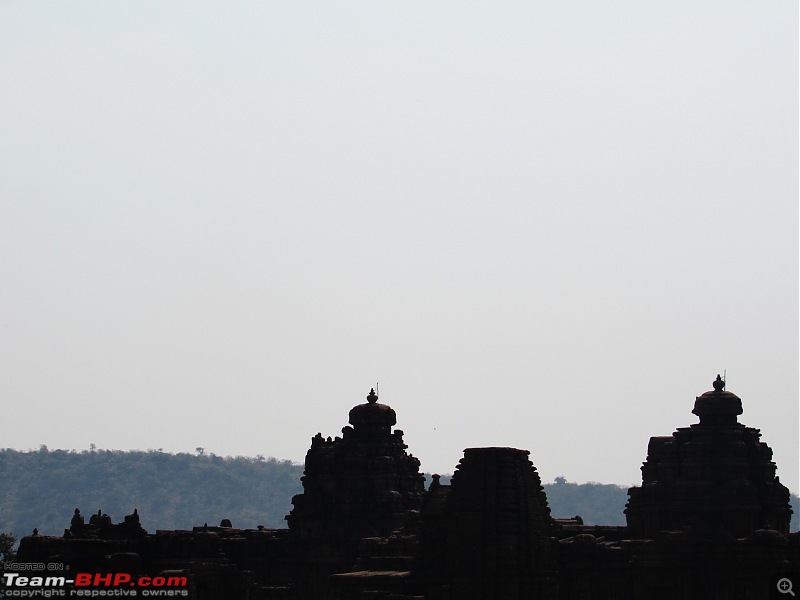 Galaganatha Temple   A damaged shivlinga in one of the temples  A blueprint of the entire Temple complex  Virupaksha Temple It is the largest and most sophisticated of the monuments at Pattadakal. The temple is notable for its range, and quality, of construction exemplifying a well-developed Dravidian architectural style. It is the only active temple within the whole complex since both the Shivlinga and Nandi are completely intact. Inside the temple there are carvings showing certain snippets from the Ramayana, Mahabharata and Panchatantra.   Carvings that represent tales from the Panchatantra  The famous story of The snake and the Mongoose  The Nandi in front of Virupaksha Temple The attention to detail is just fantastic.  From Pattadakal we went to Badami which is about 20 kms away. We had lunch on the way before going to the famous Badami Cave Temples. Badami The Badami cave temples are a complex of four Hindu, a Jain and possibly Buddhist cave temples. Cave 1 is dedicated to lord Shiva, while Cave 2 and 3 are dedicated to lord Vishnu. Cave number 4 is dedicated to Jainism. The caves are carved out of soft sandstone. Nataraja or Dancing Shiva  Lord Vishnu  Narasimha  Roof carvings in one of the caves  Bahubali in Cave 4 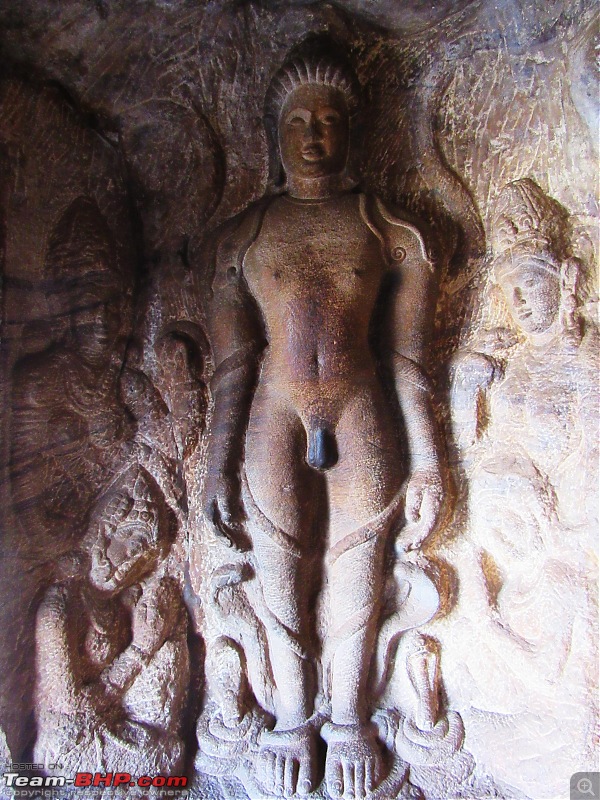 Bhutnatha Temple Complex near the caves  Later we visited the Badami Banashankari Temple and returned back to Hospet by 7 pm. That brought an end to Day 2 of our trip. The next day was for exploring Hampi. Last edited by Futurestan : 4th January 2019 at 10:26. |
| |  (14)
Thanks (14)
Thanks
|
| The following 14 BHPians Thank Futurestan for this useful post: | dailydriver, darklord, ganeshb, GTO, hemanth.anand, InControl, jailbird_fynix, paragsachania, rj22, Samba, SDP, SmartCat, sukiwa, Voodooblaster |
| | #4 |
| Newbie Join Date: Nov 2018 Location: Bengaluru
Posts: 21
Thanked: 175 Times
| Re: Hampi,Badami and more: A journey back in time! Day3-Monday,24th December Hospet-Hampi-Kamalapur We had our breakfast, checked out of our hotel and it was time for us to enter the glorious capital city of the Vijayanagara Empire. Our first stop of the day would be the Vijaya Vitthala Temple. Vijaya Vitthala Temple Vijaya Vitthala Temple is one of the largest and most famous structure in Hampi. It is famous for its architecture and craftmanship. This temple complex houses the famous Stone Chariot and also the musical pillars. This temple was built during the reign of King Devaraya II and later on was expanded by King Krishnadevaraya to give it its present look. The Gopuram  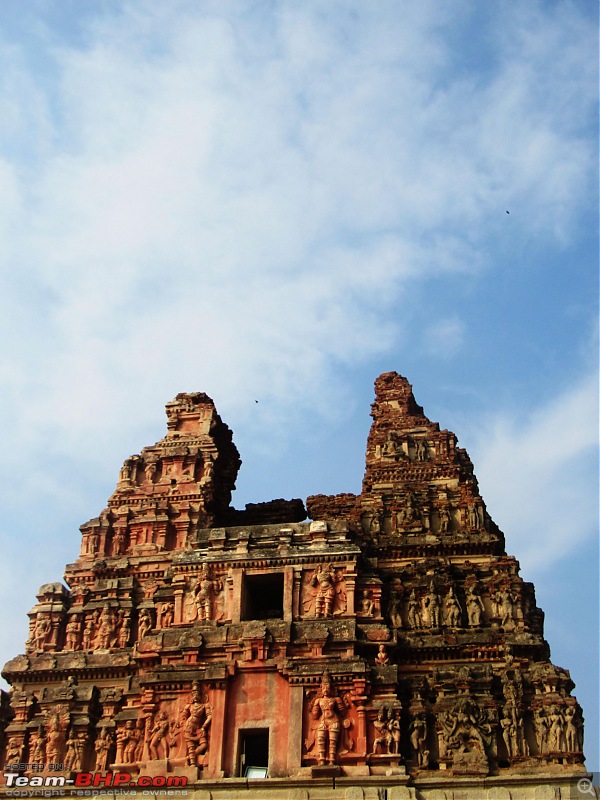 The famous Stone Chariot 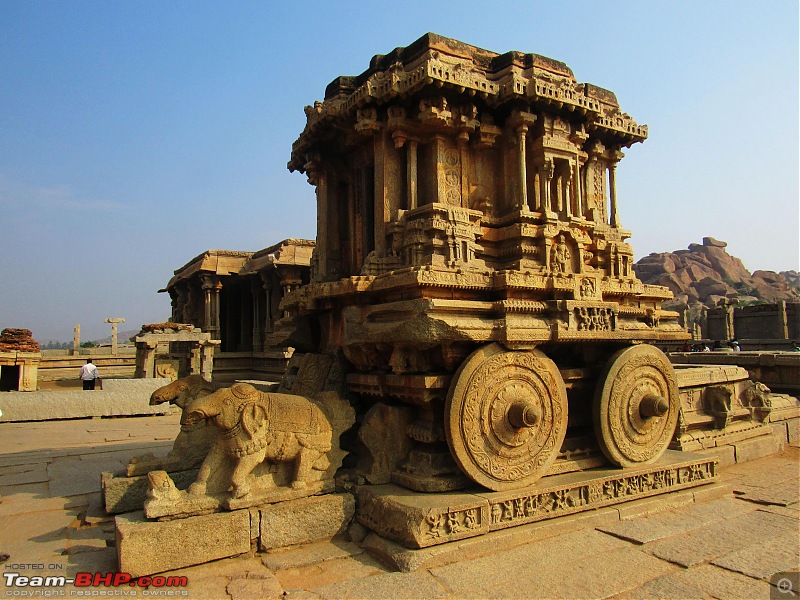 When the Stone Chariot was built it had horse figures at the front but those were destroyed when attacked by the Sultanates. So, the Archaeological Survey of India (ASI) installed elephant figures in front. If you look at the above image you can spot the gap between the elephants and the chariot. The temple complex and the musical pillars    Some new pillars have been brought in by the ASI for renovation. These help you understand as to what could have been close to the original colour of the temple complex when it was built a few centuries ago.  A figure of a dragon spitting out fire on the side of the temple  Few more shots taken within the temple    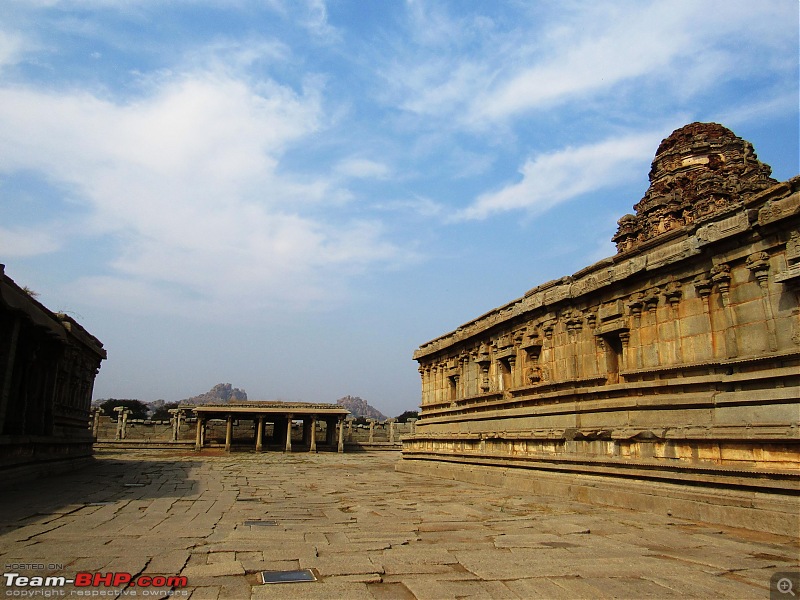 Stone Chariot and the Gopuram  The Bazaar and the tank in front of the Temple Complex   Ugra Narasimha Next, we visited the Ugra Narasimha Statue The original statue contained the statue of goddess Lakshmi, sitting on his lap. But this statue has been damaged seriously during the raid leading to the fall of Vijayanagara.   A side view to give you a perspective as to how large this statue is.  Krishna Temple Next stop was the Krishna Temple. The main idol installed in the temple was the figure of Balakrishna (Lord Krishna as infant). This idol is now displayed in the state museum at Chennai. The Krishna Temple also has a long market place and a tank in front of it just like the Vijaya Vitthala Temple. A few shots of the temple complex and the main gopuram.   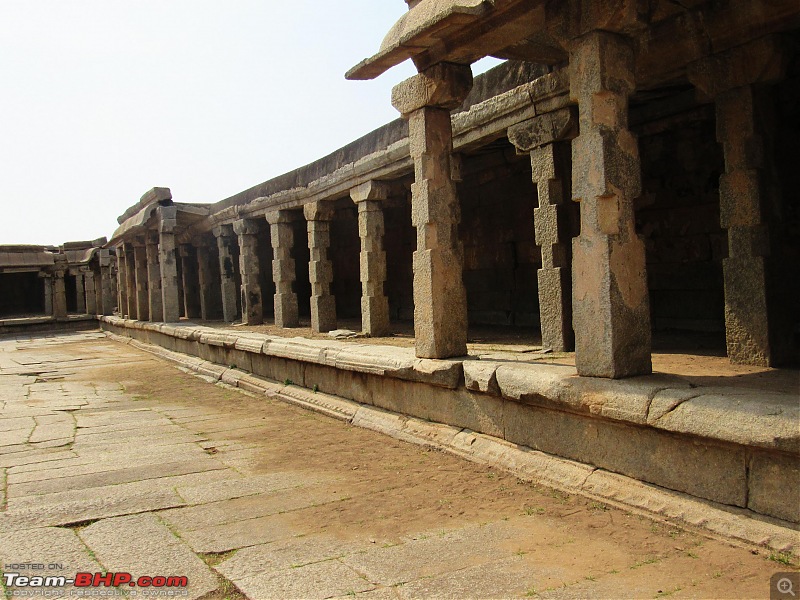 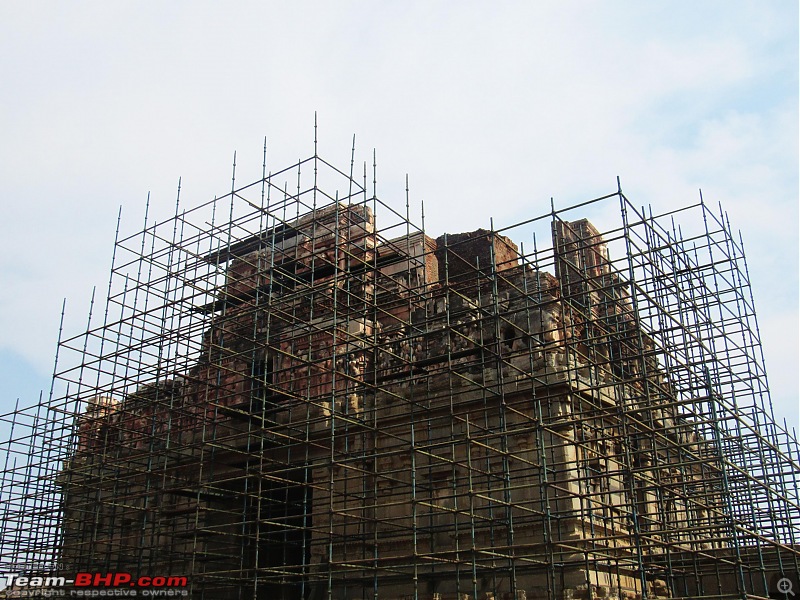 Hemakuta Hill After visiting the Krishna Temple, we began climbing the Hemakuta Hill. It is believed that it’s on this hill that Lord Siva did penance before marrying a local girl Pampa. One will spot many small shrines as they start climbing the Hemakuta Hill. Sasivekalu Ganesha is one of them  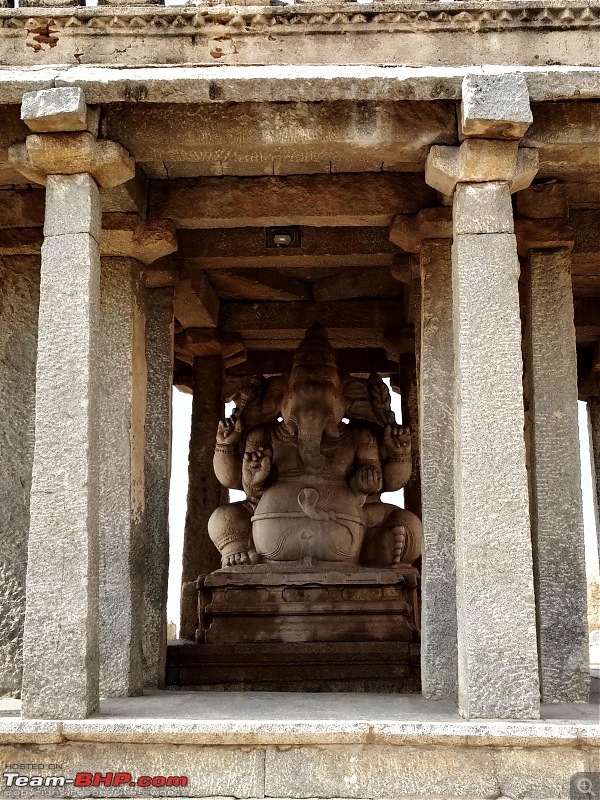 Kadalekalu Ganesha  A carving on top of Hemakuta Hill  One of the many small shrines atop the hill  As you keep walking further, you get the first glimpses of the Virupaksha Temple. Virupaksha Temple Virupaksha Temple is the main centre of pilgrimage at Hampi. This is still an active and worship takes place everyday. What used to be a small shrine grew into a large complex under the Vijayanagara rulers. The temple is dedicated to Lord Shiva, known here as Virupaksha. This temple complex also had a market place in front of it where rubies and diamonds were sold. There was a festival on the day we visited Hampi and many vendors were selling their wares outside the temple complex and this gave us an idea as to how busy this place could have been during the Vijayanagara period! First glimpses of Virupaksha Temple from Hemakuta Hill   Front View of the Gopuram  After darshan at the Virupaksha Temple we had lunch at the Mango Tree restaurant which is at a walkable distance from the Virupaksha Temple. After lunch we headed towards the Zenana Enclosure. |
| |  (13)
Thanks (13)
Thanks
|
| The following 13 BHPians Thank Futurestan for this useful post: | darklord, ganeshb, GTO, hemanth.anand, jailbird_fynix, paragsachania, Rajeevraj, Samba, SDP, SNayak, sukiwa, v12, Voodooblaster |
| | #5 |
| Newbie Join Date: Nov 2018 Location: Bengaluru
Posts: 21
Thanked: 175 Times
| Re: Hampi,Badami and more: A journey back in time! Day 3 Continued … Zenana Enclosure and Elephant Stable The Zenana Enclosure contains the Lotus Mahal. The Lotus Mahal is built in the Indo Islamic style and it is 2 storeyed. The Lotus Mahal  Craftmanship on the arches of the Lotus Mahal: All the decorations are made to seem like they are coming out of a lion’s mouth. 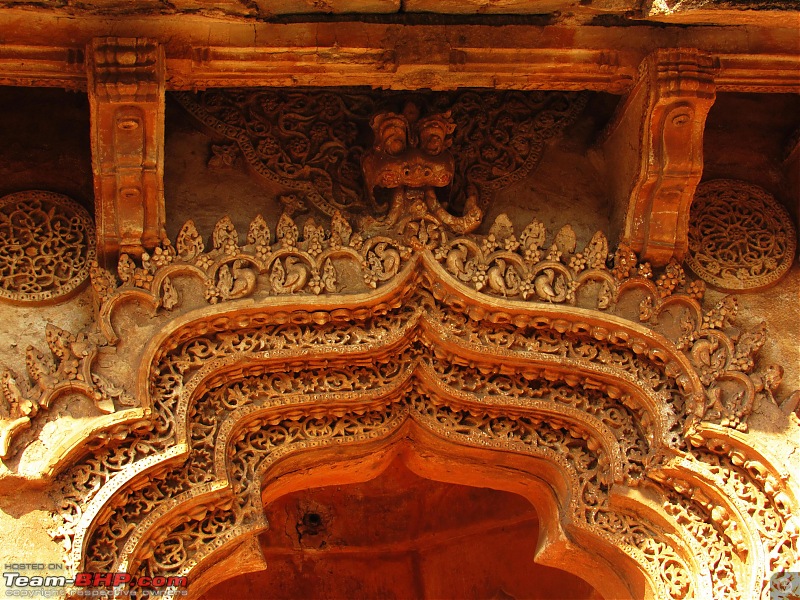 A tower within the Zenana Enclosure  Elephant Stable There are a total of 11 chambers with an alternating pattern of domes on either side of the middle structure which has steps to go up.  Hazara Rama Temple After the Zenana Enclosure, the next stop for us was the Hazara Rama Temple. This temple was only open to the Royal Family and hence it had very intricate carvings. The inner walls of the temple complex have carvings representing the tales from the Ramayana. The outer walls have carvings representing the festivities of Dasara and Holi. Inside the Hazara Rama Temple 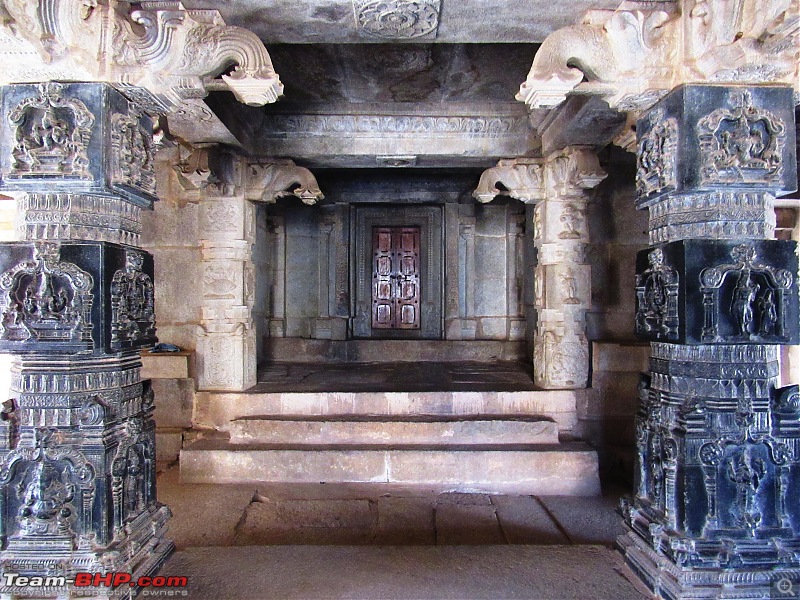  An outside shot  Outer wall of the temple representing various festivities 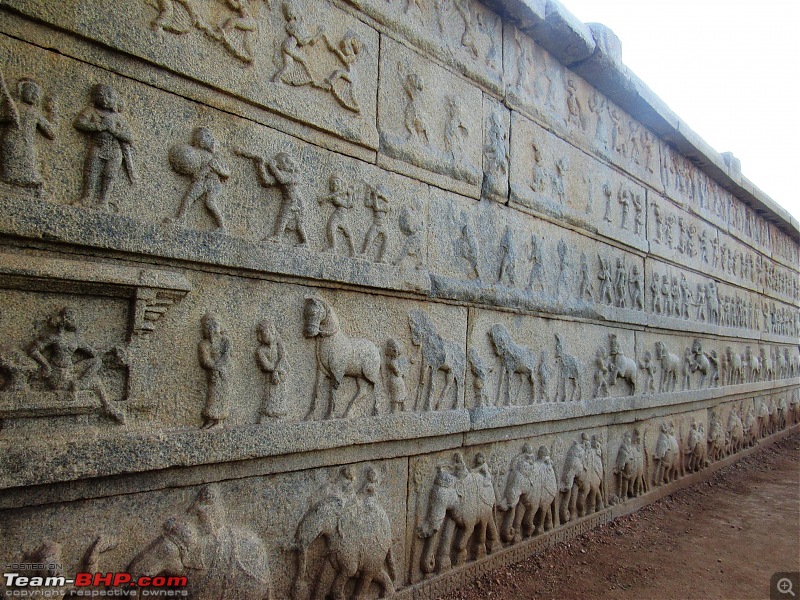 Mahanavami Platform The Mahanavami platform is situated within the royal centre that also used to house the palace. 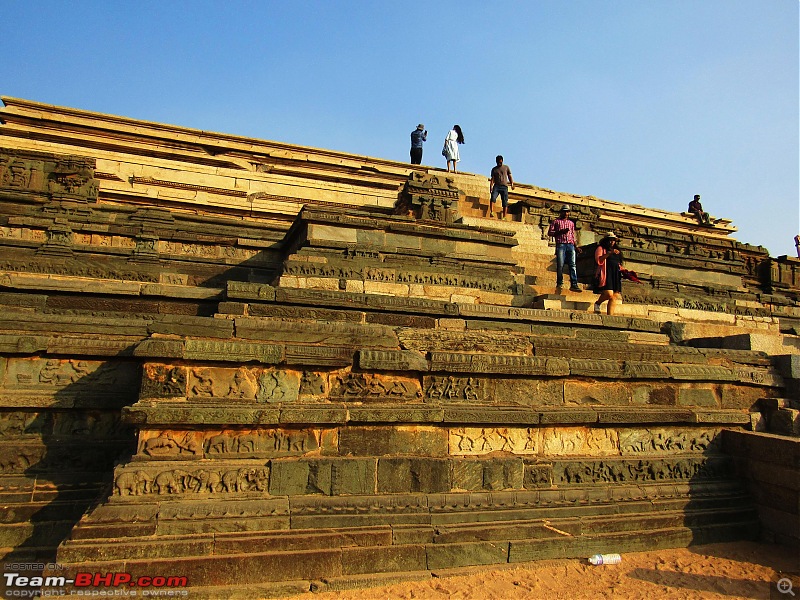 The surrounding area as seen from the platform As you can see only the base or foundation of the palace area remains because the upper structure being made of wood was burnt down by the invaders.   Stepped Tank and Aqueduct are present near the Mahanavami Platform    One random shot of our Creta at the parking lot  Queen’s Bath Our second last stop for the day was the Queen’s Bath. This is where the king and his wives used to come for some enjoyment. It has an open pond in the middle with several balconies surrounding it. It is believed that this pond was filled with fragranced water.   We visited the archaeological museum and later checked into our hotel room at KSTDC Mayura in Kamalapur. This was a day very well spent as we got to know a lot about the rich culture that existed a few centuries ago. Hampi is very captivating and sparks a lot of curiosity within you. |
| |  (13)
Thanks (13)
Thanks
|
| The following 13 BHPians Thank Futurestan for this useful post: | arvindmanju, dailydriver, darklord, GTO, jailbird_fynix, mpksuhas, paragsachania, Samba, SDP, SmartCat, sukiwa, v12, Voodooblaster |
| | #6 |
| Newbie Join Date: Nov 2018 Location: Bengaluru
Posts: 21
Thanked: 175 Times
| Re: Hampi,Badami and more: A journey back in time! Day4-Tuesday,25th December Kamalapur-TB Dam-Chitradurga-Bangalore This was the final day of our trip and we planned to visit Chitradurga which is enroute to Bangalore. Before going towards Chitradurga, we decided to stop at Tungabhadra Dam in Hospet. We had our breakfast and left from Kamalapur at around 8:30 am. We fuelled up at Hospet. Calculated the fuel efficiency and found it out to be 13.5 kms per litre.  Tungabhadra Dam The total length of the dam is 2449 m and has a height of 49.5 m from its deepest foundation. You need to board a bus to get all the way to the top and get an excellent view of the whole dam along with the reservoir. The journey is about 7 kms to and fro. These are a few images captured from the highest point that you can go to, to view the dam.   Images captured from a lower level    The final stop before we headed to Bangalore was Chitradurga Fort. We reached Chitradurga at around 12:30 pm and had our lunch before heading towards the Chitradurga fort. Chitradurga Fort  The Nayakas of Chitradurga were the primary forces behind the vast expansion of the Chitradurga Fort. Nayakas were initially under the rule of the Vijayanagara Empire, but later on declared independence after the fall of the Vijayanagara Empire in 1565. Major expansions in the fort took place between the 15th and 18th centuries. The fort was taken over by Hyder Ali in1779. The fort was later captured by the British forces 20 years later when they defeated his son, Tipu Sultan. The fort had seven concentric fortification walls. It also had warehouses for grains and oil, water reservoirs and many ancient temples. Besides this the fort has many secret passages and hideouts. High walls in the fort Really incredible that they managed to get such heavy stones so high up to build these walls     Few of the many reservoirs within the fort The fort was said to have never faced a shortage of water.   A gateway and a pathway within the fort 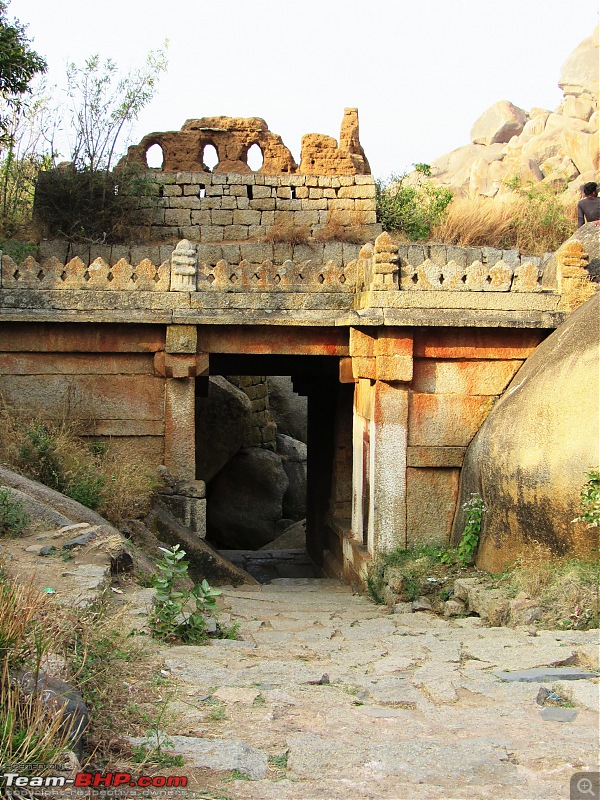 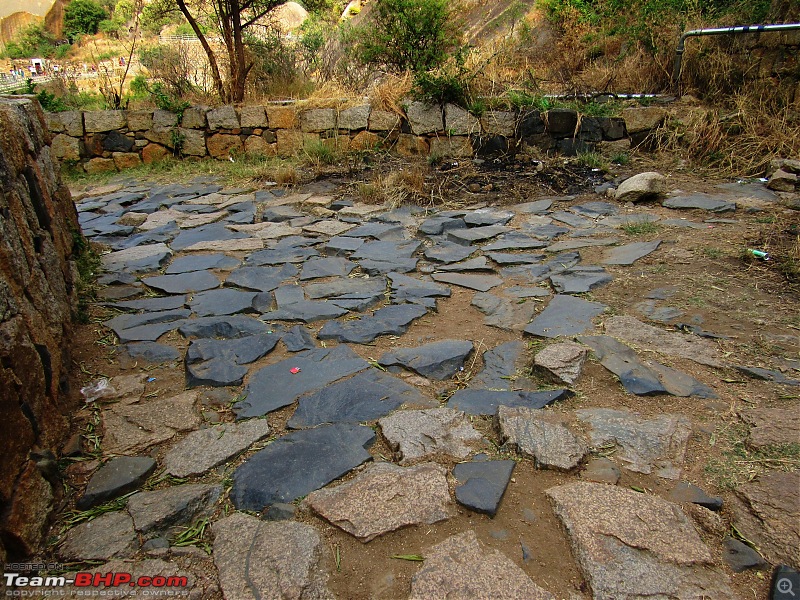 Pillars for a swing  A tank which was used to store coloured water for various festivals  The ruins of the palace  The fort is really huge and if one wishes they can spend an entire day to explore the complete fort. There is no proper pathway to get to certain higher parts of the fort and so if one wishes to visit the highest parts of the fort, one needs to trek to get up there. It is advisable to carry enough quantity of water with you when you walk around the fort as you tend to get dehydrated. It takes a minimum of around 2-3 hours to cover the important aspects of the fort. We left from Chitdradurga at around 5:30 pm and had our dinner once we entered Bangalore city.  We reached home at around 10:00 pm and this was the final reading on the odo.  This brought an end to another successful and very knowledgeable journey of four days. Thanks for reading through. |
| |  (26)
Thanks (26)
Thanks
|
| The following 26 BHPians Thank Futurestan for this useful post: | arvindmanju, dailydriver, darklord, FrodoOfTheShire, ganeshb, gauravanekar, GTO, hemanth.anand, jailbird_fynix, mpksuhas, paragsachania, procrj, R-Six, Red Liner, Samba, Santoshbhat, SDP, sivadas, SNayak, Storm2.0, sukiwa, supertinu, v12, VaibhaoT, vidyanand, Voodooblaster |
| | #7 |
| Team-BHP Support  Join Date: Jan 2010 Location: Mumbai
Posts: 4,733
Thanked: 11,297 Times
| Re: Hampi,Badami and more: A journey back in time! Thread moved out from the Assembly Line. Thanks for sharing! |
| |  (2)
Thanks (2)
Thanks
|
| The following 2 BHPians Thank SDP for this useful post: | Futurestan, GTO |
| | #8 |
| Distinguished - BHPian  | Re: Hampi,Badami and more: A journey back in time! Nice log there Futurestan you've covered almost all of the important places in and around Hampi. I don't think you could've have done more in the 4 days available to you. The only thing you could've done was have lunch at the Mango tree restaurant in Hampi  I spent 4 years of my student life in Bellary and every year on Holi I used to visit Hampi to avoid playing colours. Whenever I visit, I feel time has stood still. A movie plays in my mind on the grandeur of the Vijayanagara Empire Any reason why you rented out an Etios instead of driving your own Creta? |
| |  (3)
Thanks (3)
Thanks
|
| The following 3 BHPians Thank hemanth.anand for this useful post: | Futurestan, paragsachania, Voodooblaster |
| | #9 | ||
| Newbie Join Date: Nov 2018 Location: Bengaluru
Posts: 21
Thanked: 175 Times
| Re: Hampi,Badami and more: A journey back in time!
Thank you! Quote:
Quote:
Nothing in particular. A part of the road from Badami to Hospet is single laned and driving at night after all the exhaustion is what we wanted to avoid. | ||
| |  ()
Thanks ()
Thanks
|
| | #10 | |
| BHPian | Re: Hampi,Badami and more: A journey back in time! Quote:
My thread : https://www.team-bhp.com/forum/trave...deep-dive.html (Hyderabad to Hampi, Deep Dive) Sharing few pictures of Punto in the terrain.   Thanks for bringing back great old memories. Keep travelling and sharing such wonderful experiences. Last edited by ARAY : 17th January 2019 at 21:14. | |
| |  (2)
Thanks (2)
Thanks
|
| The following 2 BHPians Thank ARAY for this useful post: | Futurestan, Voodooblaster |
| | #11 |
| Newbie Join Date: Nov 2018 Location: Bengaluru
Posts: 21
Thanked: 175 Times
| Re: Hampi,Badami and more: A journey back in time! |
| |  (1)
Thanks (1)
Thanks
|
| The following BHPian Thanks Futurestan for this useful post: | ARAY |
| |
| | #12 |
| BHPian Join Date: Jan 2008 Location: Bangalore
Posts: 307
Thanked: 75 Times
| Re: Hampi,Badami and more: A journey back in time! Is it advisable to go Hampi next week given the flood conditions? I have a booking and looks very difficult to go there. planned to drive from bangalore to hampi. |
| |  ()
Thanks ()
Thanks
|
| | #13 | |
| Distinguished - BHPian  Join Date: May 2010 Location: Bangalore
Posts: 2,172
Thanked: 15,364 Times
| Re: Hampi,Badami and more: A journey back in time! Quote:
Around Badami, Pattadakal was also under a lot of water and roads around Badami were blocked. If more rains (and not necessarily in those two areas) are in store, then more water will be pushed into the reservoirs near Hampi and they will be forced to release more which will lead to flooding. [On a related note, hope the district administration FINALLY wakes up to the need for a pedestrian bridge from the Virupaksha Temple side to Virupapur Gaddi in Hampi. How easy it would have been for those 300 tourists to cross over if there had been a bridge, instead of the need for emergency boats and for airlifting, wasting resources and risking people!] | |
| |  ()
Thanks ()
Thanks
|
 |


